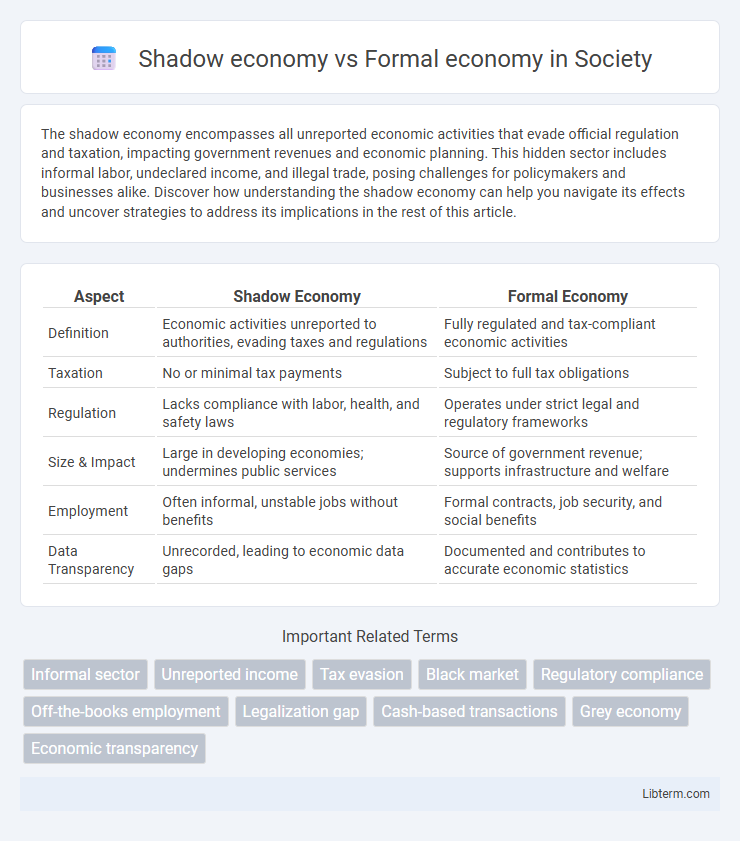The shadow economy encompasses all unreported economic activities that evade official regulation and taxation, impacting government revenues and economic planning. This hidden sector includes informal labor, undeclared income, and illegal trade, posing challenges for policymakers and businesses alike. Discover how understanding the shadow economy can help you navigate its effects and uncover strategies to address its implications in the rest of this article.
Table of Comparison
| Aspect | Shadow Economy | Formal Economy |
|---|---|---|
| Definition | Economic activities unreported to authorities, evading taxes and regulations | Fully regulated and tax-compliant economic activities |
| Taxation | No or minimal tax payments | Subject to full tax obligations |
| Regulation | Lacks compliance with labor, health, and safety laws | Operates under strict legal and regulatory frameworks |
| Size & Impact | Large in developing economies; undermines public services | Source of government revenue; supports infrastructure and welfare |
| Employment | Often informal, unstable jobs without benefits | Formal contracts, job security, and social benefits |
| Data Transparency | Unrecorded, leading to economic data gaps | Documented and contributes to accurate economic statistics |
Understanding the Shadow Economy: Key Characteristics
The shadow economy comprises unreported income from legal or illegal activities that evade government regulation and taxation, significantly impacting national GDP estimates and fiscal policies. Key characteristics include cash-based transactions, lack of official records, and limited labor protections, which contribute to widespread informality and economic distortions. Understanding these features helps policymakers design targeted interventions to improve compliance and integrate shadow activities into the formal economy.
Defining the Formal Economy: Structure and Standards
The formal economy consists of all economic activities that are regulated, documented, and taxed by government authorities, ensuring compliance with labor laws, safety standards, and financial reporting requirements. It includes registered businesses, officially recognized employment, and transparent transactions, facilitating access to credit, social security, and legal protections. The structured nature of the formal economy promotes economic stability, legal accountability, and accurate national statistics essential for policy-making.
Major Differences Between Shadow and Formal Economies
The major differences between shadow economy and formal economy lie in legality, regulation, and tax compliance; the formal economy operates under government regulation with transparent tax payments, while the shadow economy functions outside legal frameworks, evading taxes and regulations. Employment in the shadow economy is typically unregistered and informal, lacking social security benefits, unlike the formal economy where labor is contractually regulated and protected. Data on formal economic activities is systematically recorded and contributes to national statistics, whereas shadow economy transactions remain hidden, complicating accurate economic measurement and policy formulation.
Drivers Behind the Growth of the Shadow Economy
The shadow economy expands due to high taxation, complex regulations, and insufficient enforcement of labor laws, driving businesses and individuals to operate informally to avoid costs and legal constraints. Economic instability and lack of social security incentives also push workers towards the informal sector where transactions remain unreported. Limited access to formal financial services and bureaucratic barriers further reinforce reliance on shadow economic activities.
Impacts of the Shadow Economy on National Development
The shadow economy, encompassing unreported and untaxed economic activities, undermines national development by reducing government revenues essential for public services and infrastructure investment. Its prevalence distorts labor markets, impedes fair competition, and erodes institutional trust, limiting effective policy implementation and economic growth. Persistent shadow economic activities also exacerbate income inequality and hinder social welfare programs, weakening overall socioeconomic stability.
Regulatory Frameworks: Formal Economy Compliance
The formal economy operates under stringent regulatory frameworks that mandate compliance with tax laws, labor standards, and reporting requirements, ensuring transparency and accountability. In contrast, the shadow economy operates outside these legal boundaries, avoiding regulatory compliance to escape taxes and oversight. Robust regulatory frameworks in the formal economy promote fair competition, protect workers' rights, and enable accurate economic data collection for policymaking.
Tax Evasion and the Shadow Economy
The shadow economy, characterized by unreported income and undeclared work, significantly contributes to tax evasion, reducing government revenues and undermining public services. Formal economies rely on transparent tax reporting and compliance, enabling effective fiscal policy and social welfare programs. Strategies targeting tax evasion within the shadow economy include improving tax enforcement, simplifying tax systems, and increasing the use of digital payment methods to enhance traceability.
Labor Market Dynamics: Informal vs. Formal Employment
The shadow economy significantly influences labor market dynamics by absorbing a large portion of informal employment, which often lacks legal protections, social benefits, and job security compared to formal employment. Informal labor markets tend to exhibit higher volatility, lower wages, and limited access to professional development, impacting overall economic productivity and worker welfare. In contrast, formal employment in the regulated economy ensures compliance with labor laws, social security contributions, and better working conditions, fostering more stable and inclusive labor market growth.
Government Strategies to Curb Shadow Economic Activity
Governments implement stricter tax enforcement, enhance digital transaction monitoring, and promote financial transparency to curb shadow economic activity, aiming to increase tax revenues and reduce illicit trade. Strengthening legal frameworks and incentivizing businesses to formalize operations through simplified regulations and access to credit further encourage compliance. Public awareness campaigns and collaboration with international organizations help dismantle informal networks and promote economic formalization.
Future Outlook: Integrating the Shadow Economy into the Formal Sector
Integrating the shadow economy into the formal sector promises to expand tax bases and improve economic transparency. Advances in digital financial technologies and enhanced regulatory frameworks enable better identification and inclusion of informal activities. Successful integration can boost economic growth, increase employment opportunities, and foster sustainable development globally.
Shadow economy Infographic

 libterm.com
libterm.com